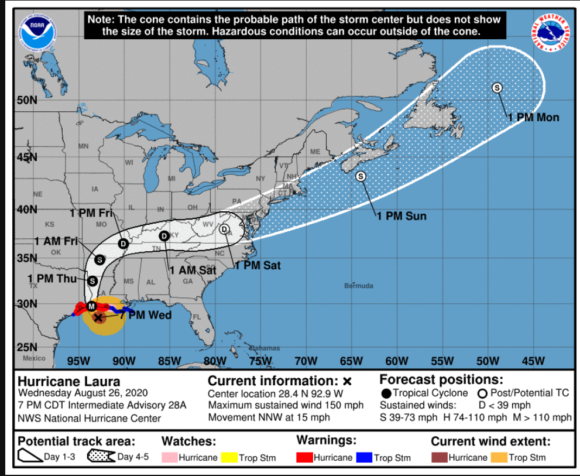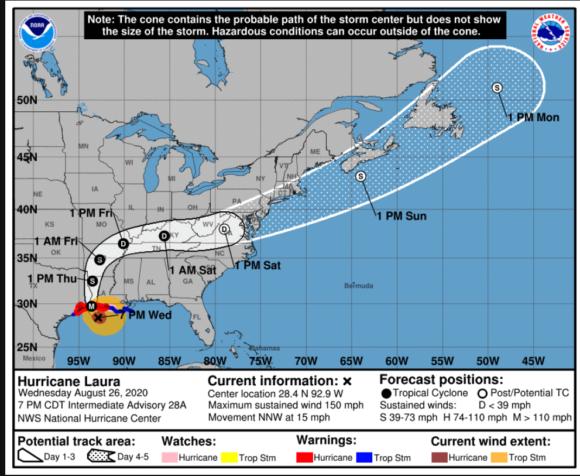Ratings analysts A.M. Best and Moody’s are expecting property/casualty insurers and reinsurers to suffer meaningful losses from Hurricane Laura.
A.M. Best expects losses from Hurricane Laura to place added stress on its rated insurance companies’ balance sheets, which it adds have already been weakened by the COVID-19 pandemic.
While reinsurance may help mitigate losses, the losses from the hurricane will challenge future risk management strategies, as loss-affected areas will see increases in reinsurance rates that are already hardening, A.M. Best says in a commentary, “Hurricane Laura Losses Could Further Stress Insurers’ 2020 Earnings.”
A.M. Best states that although the capital position of smaller companies may be at greater risk, “prudent enterprise risk management strategies could result in losses that affect earnings more than capital.”
The A.M. Best commentary further notes that many rated insurers have purchased first-event cover well-above the estimated loss associated with a 1-in-100-year hurricane, and programs often include drop-down and reinstatement features that insulate a company from a second event.
Hurricane Laura’s expected landfall on the Louisiana-Texas border is similar to that of Hurricane Rita in 2005. Rita resulted in $6.4 billion in insured losses on an estimated $25.2 billion in total damage.
(Chuck Watson of Enki Research blogged this morning after Laura made landfall that while it is too early to gauge the full impact, Laura looks to be in company with 2005’s Hurricane Rita as far as overall damage is concerned. “The latest computer model estimates are around $25 Billion when all is said and done, which puts Laura in the same company as the inflation/growth adjusted Rita ($18 Billion in 2005, probably $24 Billion today),” Watson wrote.)
A.M. Best feels losses from the hurricane may be contained somewhat if Houston, the most flood-prone city in the United States, is spared a torrential rain event, according to A.M. Best analysts.
Moody’s
Moody’s said regional carriers are most vulnerable. “Given their careful monitoring of exposures, geographic diversification, high quality reinsurance protection and strong capital bases, we believe these large national carriers can withstand this hurricane event. Regional insurers and state insurance funds face greater impact based on their geographic concentrations,” the ratings agency said in a report.
Moody’s also expects losses to hit reinsurers as well as insurers. “The U.S. Gulf Coast is a peak catastrophe zone for reinsurers, and those with exposure to Texas and Louisiana could incur meaningful losses,” Moody’s stated.
The Texas Windstorm Insurance Association (TWIA) and the Louisiana Citizens Property Insurance Corp., the states’ property insurers of last resort, are likely to absorb significant losses as well, according to Moody’s.
If there is widespread flooding, economic losses could be significant, however since homeowners policies typically do not cover flood damage, the government-backed National Flood Insurance Program would be affected.
Stock Analysts
Insurance stocks analyst Elyse Greenspan from Wells Fargo Securities believes that an insured loss event in the $8-15 billion range appears most likely. An insured loss event of $12 billion would lower equity by 1.6% on average and would represent 10% of full-year 2020 earnings for the P/C stocks, Greenspan reported.
KBW analyst Meyer Shields said that despite Laura’s initial intensity, insured losses should remain “quite manageable” since the landfall avoided major cities like Houston and New Orleans, while accumulating catastrophe losses (including hurricane and derecho losses) to date this year “should reinforce pricing discipline within and beyond property catastrophe reinsurance.” Shields estimates that an $8 billion industry loss would account for less than 3% of mid-year common equity for every company KBW covers, before considering taxes and mitigating reinsurance.
Inland Risk
In addition to strong winds, storm surge and river flooding may have devastating effects dozens of miles inland, with potential isolated tornados.
Still, the storm surge could reach 13 feet and push 30 miles inland or more along Louisiana’s southwestern coast.
Inland flood risk is possible as far north and east as Arkansas and the Ohio and Tennessee valleys.
A.M. Best said COVID-19 likely will exacerbate inherent price inflation for construction supplies and contractors following hurricane events, as adjusting claims, transporting goods and sourcing labor may be even more costly than usual.
Technology may be a mitigating factor in this case, as the use of drones may help insurers assess losses and estimate replacement costs, A.M. Best added.

Topics Catastrophe Natural Disasters Carriers Texas Profit Loss Flood Louisiana Reinsurance Hurricane Property AM Best Homeowners Property Casualty State Farm
Was this article valuable?
Here are more articles you may enjoy.



 Litigation Funding, Other New Laws in SE States Could Impact Liability Insurance
Litigation Funding, Other New Laws in SE States Could Impact Liability Insurance  Good Times for US P/C Insurers May Not Last; Auto Challenges Ahead
Good Times for US P/C Insurers May Not Last; Auto Challenges Ahead  CRC Group Signs Agreement to Acquire Euclid Transactional
CRC Group Signs Agreement to Acquire Euclid Transactional  Four in New Jersey Face Charges in Alleged $250K Travel Insurance Scam
Four in New Jersey Face Charges in Alleged $250K Travel Insurance Scam 

